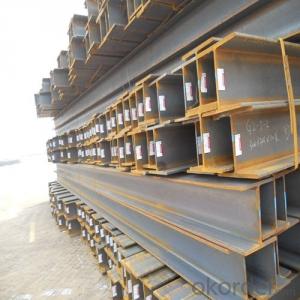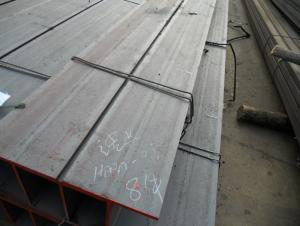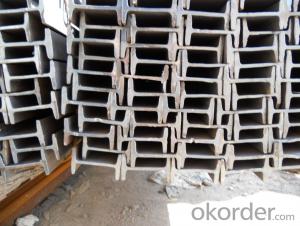Hot Rolled H-Beam Structure Steel Q235 Good Price Made In China
- Loading Port:
- Tianjin
- Payment Terms:
- TT OR LC
- Min Order Qty:
- 500 m.t.
- Supply Capability:
- 5000 m.t./month
OKorder Service Pledge
OKorder Financial Service
You Might Also Like
Specifications of Hot Rolled H-Beam Steel
1. Standard: JIS G3101
2. Grade: SS400 or Equivalent
3. Length: 6m,10m, 12m as following table
4. Invoicing on theoretical weight or actual weight as customer request
5.Payment: TT or L/C
6. Sizes:
SIZE(mm) | DIMENSION(kg/m) |
100*100 | 16.9 |
125*125 | 23.6 |
150*75 | 14 |
150*150 | 31.1 |
148*100 | 20.7 |
198*99 | 17.8 |
200*100 | 20.9 |
248*124 | 25.1 |
250*125 | 29 |
300*150 | 36.7 |
298*149 | 32 |
200*200 | 49.9 |
294*200 | 55.8 |
346*174 | 41.2 |
350*175 | 49.4 |
244*175 | 43.6 |
175*175 | 40.4 |
294*200 | 55.8 |
298*201 | 64.4 |
346*174 | 41.2 |
350*175 | 49.4 |
400*200 | 65.4 |
396*199 | 56.1 |
450*200 | 74.9 |
446*199 | 65.1 |
340*250 | 78.1 |
500*200 | 88.1 |
300*150 | 36.7 |
Usage & Applications of Hot Rolled Structural Steel H Beam
Commercial building structure ;Pre-engineered buildings; Machinery support structure; Prefabricated structure; Medium scale bridges; Ship-building structure. etc.
Packaging & Delivery of Hot Rolled Structural Steel H Beam
1. Packing: it is nude packed in bundles by steel wire rod
2. Bundle weight: not more than 3.5MT for bulk vessel; less than 3 MT for container load
3. Marks:
Color marking: There will be color marking on both end of the bundle for the cargo delivered by bulk vessel. That makes it easily to distinguish at the destination port.
Tag mark: there will be tag mark tied up on the bundles. The information usually including supplier logo and name, product name, made in China, shipping marks and other information request by the customer.
If loading by container the marking is not needed, but we will prepare it as customer request.
4. Transportation: the goods are delivered by truck from mill to loading port, the maximum quantity can be loaded is around 40MTs by each truck. If the order quantity cannot reach the full truck loaded, the transportation cost per ton will be little higher than full load.
5. Delivered by container or bulk vessel
- Q:Does the cross section of corrugated steel H have this section in PKPM?
- H type steel corrugated webs, by corrugated webs and the upper and lower flange, flange and bottom flange plate in parallel or at some angle, corrugated webs perpendicular to the flange between the side fillet weld may be double fillet, depending on the corrugated web thickness and welding process decision
- Q:Can steel H-beams be customized to specific lengths?
- Yes, steel H-beams can be customized to specific lengths. Steel H-beams are commonly used in construction and are available in various standard lengths. However, if the standard lengths do not meet the specific requirements of a project, they can be customized to the desired length. This can be done by cutting the beams to the required length and then welding or bolting the ends together to create the desired length. Customizing the length of steel H-beams allows for more flexibility in construction projects and ensures that the beams fit perfectly for a specific application.
- Q:Are steel H-beams suitable for automotive assembly plants?
- Steel H-beams are a suitable option for automotive assembly plants. They are widely used in construction and industrial sectors because of their strength, durability, and ability to bear heavy loads. Automotive assembly plants can utilize these beams for various purposes like supporting overhead cranes, creating structural frameworks for assembly lines, and providing stability to the entire building structure. The steel H-beams have a high strength-to-weight ratio, making them perfect for withstanding heavy machinery, equipment, and constant vehicle movement during the assembly process. Furthermore, they offer design flexibility, enabling the construction of large open spaces without the need for excessive support columns. This optimizes the layout and efficiency of the assembly plant. In summary, steel H-beams are a dependable and practical choice for automotive assembly plants, as they provide the necessary strength and stability required in demanding industrial environments.
- Q:Can steel H-beams be used in the construction of automotive or manufacturing plants?
- Indeed, automotive or manufacturing plants can utilize steel H-beams for their construction purposes. The prevalent usage of steel H-beams in construction stems from their remarkable strength-to-weight ratio and capacity to bear hefty loads. Their suitability for extensive structures such as automotive or manufacturing plants lies in their ability to offer robust and enduring support beams. Consequently, these beams confer stability and structural integrity upon the edifice, guaranteeing its resilience against the weight of machinery, equipment, and materials. Moreover, steel H-beams possess versatility, enabling convenient fabrication and customization to satisfy specific design requisites. Consequently, they represent an ideal selection for construction endeavors of this nature.
- Q:How do steel H-beams perform in bridge expansions or contractions?
- Steel H-beams are widely used in bridge construction due to their excellent performance during expansions or contractions. These beams are designed to accommodate thermal expansion and contraction, which occur as a result of temperature changes. When a bridge is subjected to temperature variations, the steel H-beams expand or contract accordingly. This is because steel has a relatively high coefficient of thermal expansion, meaning it expands or contracts more than other materials when exposed to heat or cold. However, the design of H-beams takes this into consideration. They are equipped with sufficient flexibility and structural integrity to withstand these thermal movements without causing any significant damage or deformation to the bridge structure. The H-beams can elongate or contract within their allowable limits, ensuring the bridge remains safe and functional. To further enhance their performance, bridge engineers often incorporate expansion joints into the design. These joints provide additional space for the H-beams to expand or contract without exerting excessive stress on the bridge. Expansion joints also help to prevent the transfer of these thermal movements to other components of the bridge, ensuring its overall stability. In summary, steel H-beams perform exceptionally well in bridge expansions or contractions. Their design allows for the necessary flexibility to accommodate thermal movements, while maintaining the structural integrity of the bridge. The inclusion of expansion joints further enhances their performance, ensuring the bridge's longevity and safety.
- Q:How do steel H-beams perform in structures subjected to vibration?
- Steel H-beams are known for their excellent performance in structures subjected to vibration. Their robust and rigid construction helps to minimize the effects of vibration, providing enhanced stability and structural integrity. The H-shaped cross-section of these beams ensures efficient load distribution, reducing the chance of resonance and dampening vibrations. Overall, steel H-beams are highly effective in withstanding and mitigating the impact of vibration in structures.
- Q:Are steel H-beams susceptible to corrosion?
- Indeed, corrosion can affect steel H-beams. Steel, deriving mainly from iron, has a tendency to oxidize when exposed to moisture and oxygen. This oxidation results in the creation of iron oxide, commonly referred to as rust. Corrosion can manifest on both the surface and interior of the H-beams if moisture becomes trapped inside. Nevertheless, susceptibility to corrosion can be lessened through diverse preventive actions like the application of protective coatings, galvanization, or the employment of stainless steel H-beams. Consistent maintenance and inspections are also crucial in promptly detecting and addressing any indications of corrosion.
- Q:How are steel H-beams used in building bridges?
- Steel H-beams are commonly used in building bridges due to their structural strength, durability, and ability to bear heavy loads. These beams are designed in the shape of an "H" to provide maximum strength and support when used horizontally as bridge girders. When constructing a bridge, steel H-beams are used to create the main framework or superstructure of the bridge. These beams are typically placed horizontally and span across the supports or piers of the bridge. They are often used in pairs, with a vertical column or pier in the center, to form a truss-like structure. The H-beams are joined together using welding or bolting techniques to ensure stability and rigidity. This allows them to distribute the weight of the bridge evenly, preventing any excessive stress or strain on specific sections. The beams are also designed to be resistant to bending or deformation, making them ideal for bridges that need to span long distances. In addition to their load-bearing capabilities, steel H-beams can also be used to support various bridge components, such as decks, railings, and utility systems. These beams can be integrated into the overall bridge design to provide additional strength and stability. Overall, steel H-beams are essential components in building bridges as they provide the necessary structural integrity, strength, and load-bearing capacity required for safe and efficient transportation. Their versatility and reliability make them a popular choice among engineers and bridge builders worldwide.
- Q:Can steel H-beams be used in cold storage facilities?
- Indeed, cold storage facilities can utilize steel H-beams. These beams are frequently employed in construction due to their robustness and endurance, rendering them well-suited for a multitude of purposes, including cold storage facilities. The distinctive H shape of these beams grants them exceptional load-bearing capabilities, enabling them to bear substantial burdens such as insulation panels and refrigeration equipment. Furthermore, steel exhibits remarkable resistance to temperature fluctuations and can endure the frigid temperatures commonly encountered in cold storage facilities without compromising its structural integrity. Consequently, steel H-beams present a fitting option for construction within cold storage facilities.
- Q:What are the different connection types for steel H-beams?
- There are several different connection types that can be used for steel H-beams, depending on the specific application and structural requirements. One common connection type is the welded connection. In this method, the H-beams are welded together using a combination of heat and pressure. This creates a strong and durable connection that is capable of withstanding significant loads. Welded connections are often used in heavy-duty applications where strength is a primary concern. Another connection type is the bolted connection. This involves using bolts or screws to connect the H-beams together. Bolted connections are advantageous because they can be easily disassembled and reassembled if needed. Additionally, they allow for a certain degree of flexibility and adjustment during installation. However, bolted connections may not be as strong as welded connections and may require periodic maintenance to ensure the integrity of the connection. Another option is the pinned connection. In this type of connection, the H-beams are connected using pins or dowels that allow for rotation at the joint. Pinned connections are often used in structures that require flexibility or where movement is expected, such as in bridges or seismic-resistant buildings. These connections allow for some degree of movement and rotation at the joint, which can help dissipate forces and reduce stress concentrations. In addition to these main connection types, there are also specialized connection methods such as moment connections and shear connections. Moment connections allow for the transfer of bending moments between the connected beams, while shear connections are designed to transfer shear forces. These specialized connections are often used in structural designs where specific loadings and requirements need to be considered. Overall, the choice of connection type for steel H-beams depends on factors such as the load requirements, structural design, expected movement, and ease of installation. It is important to consult with a structural engineer or professional to determine the most appropriate connection type for a specific application.
1. Manufacturer Overview |
|
|---|---|
| Location | |
| Year Established | |
| Annual Output Value | |
| Main Markets | |
| Company Certifications | |
2. Manufacturer Certificates |
|
|---|---|
| a) Certification Name | |
| Range | |
| Reference | |
| Validity Period | |
3. Manufacturer Capability |
|
|---|---|
| a)Trade Capacity | |
| Nearest Port | |
| Export Percentage | |
| No.of Employees in Trade Department | |
| Language Spoken: | |
| b)Factory Information | |
| Factory Size: | |
| No. of Production Lines | |
| Contract Manufacturing | |
| Product Price Range | |
Send your message to us
Hot Rolled H-Beam Structure Steel Q235 Good Price Made In China
- Loading Port:
- Tianjin
- Payment Terms:
- TT OR LC
- Min Order Qty:
- 500 m.t.
- Supply Capability:
- 5000 m.t./month
OKorder Service Pledge
OKorder Financial Service
Similar products
New products
Hot products
Related keywords






























